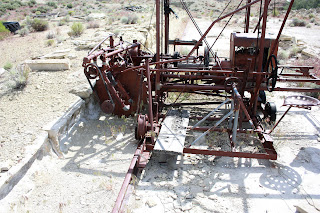On our trip to Leslie Gulch, I thought that Mike and Jan might be interested in an old quarry where some enterprising Pioneer quarried Rhyolite for some of their building materials.
One has to remember that transportation of anything in this area was a serious chore. There are few trees and the ones that are here aren't really suited for building. The Rhyolite is a common substance here, and makes some useful material for "root cellars" and fireplaces. http://hyperphysics.phy-astr.gsu.edu/hbase/geophys/rhyolite.html An earlier post to this blog has some pictures and descriptions of the Rhyolite formations in this area. http://owyheeflyer.blogspot.com/2010/08/pillars-of-rome.html
One tends to forget the hardships that our pioneers endured and the ingenious ways that they endured or overcame them. Just the remoteness of the area and the difficulty and time for travel and transportation of necessities boggles my mind. Just think, I have to invest a full day and travel 120 miles one way to get my supplies. Turn the clock back to buckboards and pack horses and you will begin to understand. On one of my earlier blogs about Bogus Creek. Mike, Roger and I visited an old homestead that the only thing standing was a Rhyolite wall that had 1870 inscribed into the wall.
I do not know the actual date of this contraption, but it can't be much earlier than 1900's since the machinery and parts used to make it were available about that era. A lot of the blocks of Rhyolite that are used in Jordan Valley and other areas have been chiseled rather than cut. I have never heard of a LeRoi motor, but the saw blades are carbide tipped. Most likely not the first blade used on it.
The machine in the left back ground was a hydraulic shear that was used to separate the slabs. At least that is my guess.
Notice the counter weight in the bucket. It is a slab of Rhyolite. Apparently the crank at the top right lifted the machinery and thus the blades on the upright pipes. The frame work is enclosed in cast Tee's that are bigger than the pipe that they are fitted over. That would allow the whole thing to raise and lower.
Various rear end transmissions are used in the gear mechanism's.
There are two blades on the machine. One to cut the vertical and one to cut the cross cut. There was apparently one to cut the floor, but I did not see either it or how it was done.
The floor of the quarry is really quite flat. It is so flat that it appears as though it had been sanded. It has not however, the saw kerf marks are quite visible.
Just a guess, but this might have been a Powder house for the quarry. It is certainly built sturdily and is not very big. Just the right size for a Pack Rat however. The roof is built of about 6x6 square cuttings from the quarry.
A Barn Owl waits for the twilight to arrive so that he can hunt.
A view of yesteryear was quite interesting, but left more questions than answers.
Sunday, July 3, 2011
Subscribe to:
Post Comments (Atom)






















No comments:
Post a Comment